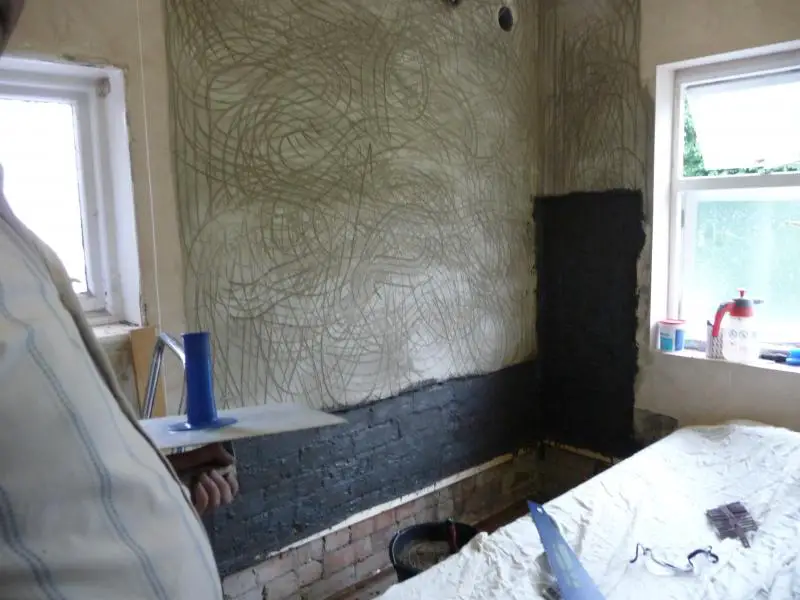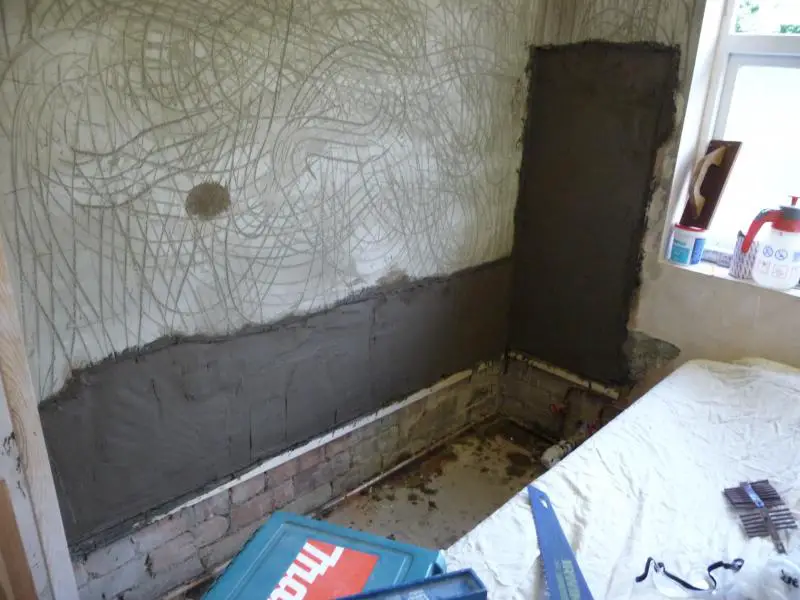- Joined
- 17 Feb 2006
- Messages
- 375
- Reaction score
- 2
- Country

Don't know what the etiquette is but this continues from:
//www.diynot.com/forums/viewtopic.php?t=230158
A newly s/c rendering job, by someone else that I wasn't happy with. 9 days old now, the render, not the topic.
I just took a bit off where the cracks were. One of the sections that sounded hollow. Sure enough it came off with hardly a whisper. A 3lb lump hammer and 1 inch chisel. I'm not a muscular build.
Stuff round it came off easily. I tried a section with no cracks whatsoever. If I started a couple of inches above a lower edge, then as 2 or 3 blows with the hammer and it would fall away.
There is the slightest trace of grey left on the bricks (except where the hollow section is, which is squeeky clean). But my memories of working for builders was that often if you did this sort of thing you'd get patches left all over the place. This is falling away in lumps.
So, not looking like there's very good adhesion.
I like the idea of sand and cement as a background for tiles. Disagree if you like, but I'm joining to existing plaster, so board type stuff is going to be awkward.
To get the best possible bond, and the least cracking etc. I'm imagining something like this:
1. PVA (or sealant of your choice, reccomendations please) on the bare brickwork the day before. To reduce suction.
2. Battens on to get everything square etc.
3. PVA on. Let it go tacky then:
4. Scratch coat, 4-1 mix with waterproofer (reccomendations please). Scratch coat on thin. Scratch it lightly when it's started to go off.
5. Next day PVA again (do I need this?)
6. Another coat 5-1 with waterproofer.
7. Repeat if necessary. One wall looks like it might take 3 coats to get it out to square. Funnily enough where the original 'plasterer' got all his cracks.
8. Remove battens and fill.
I'm a real belt and braces man, and as I'm doing it myself can afford to take my time. In fact my work patterns at the moment mean I've often got a morning/afternoon free on consecutive days.
Comments/advice please gratefully received.
//www.diynot.com/forums/viewtopic.php?t=230158
A newly s/c rendering job, by someone else that I wasn't happy with. 9 days old now, the render, not the topic.
I just took a bit off where the cracks were. One of the sections that sounded hollow. Sure enough it came off with hardly a whisper. A 3lb lump hammer and 1 inch chisel. I'm not a muscular build.
Stuff round it came off easily. I tried a section with no cracks whatsoever. If I started a couple of inches above a lower edge, then as 2 or 3 blows with the hammer and it would fall away.
There is the slightest trace of grey left on the bricks (except where the hollow section is, which is squeeky clean). But my memories of working for builders was that often if you did this sort of thing you'd get patches left all over the place. This is falling away in lumps.
So, not looking like there's very good adhesion.
I like the idea of sand and cement as a background for tiles. Disagree if you like, but I'm joining to existing plaster, so board type stuff is going to be awkward.
To get the best possible bond, and the least cracking etc. I'm imagining something like this:
1. PVA (or sealant of your choice, reccomendations please) on the bare brickwork the day before. To reduce suction.
2. Battens on to get everything square etc.
3. PVA on. Let it go tacky then:
4. Scratch coat, 4-1 mix with waterproofer (reccomendations please). Scratch coat on thin. Scratch it lightly when it's started to go off.
5. Next day PVA again (do I need this?)
6. Another coat 5-1 with waterproofer.
7. Repeat if necessary. One wall looks like it might take 3 coats to get it out to square. Funnily enough where the original 'plasterer' got all his cracks.
8. Remove battens and fill.
I'm a real belt and braces man, and as I'm doing it myself can afford to take my time. In fact my work patterns at the moment mean I've often got a morning/afternoon free on consecutive days.
Comments/advice please gratefully received.


